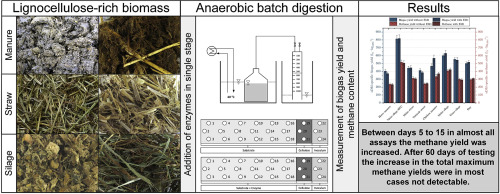Biomass & Bioenergy ( IF 6 ) Pub Date : 2019-12-12 , DOI: 10.1016/j.biombioe.2019.105442 Tobias Weide , Carolina Duque Baquero , Marion Schomaker , Elmar Brügging , Christof Wetter

|
The anaerobic digestion (AD) of the organic fractions of solid wastes has been recognized as an economical and highly renewable resource for biogas production. The challenges lie in maximizing the biodegradation of lignocellulose-rich biomasses, which requires effective strategies to prevent the underutilization of feedstocks. Enzymatic treatments for lignocellulosic degradation have huge potential because of their highly versatile and selective compounds. Moreover, such treatments mimic natural processes and require low energy inputs. This study focuses on the batch AD of a variety of lignocellulosic substrates typically used in agriculture, such as silage, straw, and the manure of various animals. The effects of five different enzyme mixtures on the increase in the gas yields of batch AD were investigated. Biogas and methane yields were systematically obtained, and then the effects on total maximum gas yields and biodegradability were determined on the basis of organic dry matter. In almost all the assays between test days 5 and 15, the biodegradability was accelerated, leading to increases of 0.3%–21.1% in methane yields as appropriate to the substrate. However, after 60 days of testing, increases (−2.7%–9.4%) in the total maximum gas yields were not detectable in most cases. It was assumed that the main effects of the enzyme treatments would be faster degradability. Furthermore, the test series with hay and different enzyme dosages showed that a higher dosage does not necessarily result in a higher effect.
中文翻译:

批量厌氧消化农业废料(青贮饲料,秸秆和动物粪便)中酶的添加对沼气和甲烷产量的影响
固体废物有机部分的厌氧消化(AD)已被认为是一种经济,高度可再生的沼气生产资源。挑战在于使富含木质纤维素的生物质的生物降解最大化,这需要有效的策略来防止原料的未充分利用。木质纤维素降解的酶处理方法因其用途广泛且具有选择性的化合物而具有巨大潜力。而且,这种处理模仿自然过程并且需要低能量输入。这项研究的重点是农业中通常使用的各种木质纤维素底物的批次AD,例如青贮饲料,稻草和各种动物的粪便。研究了五种不同酶混合物对批次AD气体收率增加的影响。系统地获得了沼气和甲烷的产率,然后根据有机干物质确定了对总最大沼气产率和生物降解性的影响。在测试第5至15天之间的几乎所有测定中,生物降解性都得到了加速,导致适合于底物的甲烷产率提高了0.3%–21.1%。然而,经过60天的测试,在大多数情况下,总最大气体产量没有增加(-2.7%–9.4%)。假定酶处理的主要作用是更快的降解性。此外,使用干草和不同酶剂量的测试系列表明,更高的剂量不一定会产生更高的效果。在测试第5至15天之间的几乎所有测定中,生物降解性都得到了加速,导致适合于底物的甲烷产率提高了0.3%–21.1%。然而,经过60天的测试,在大多数情况下,总最大气体产量没有增加(-2.7%–9.4%)。假定酶处理的主要作用是更快的降解性。此外,使用干草和不同酶剂量的测试系列表明,更高的剂量不一定会产生更高的效果。在测试第5至15天之间的几乎所有测定中,生物降解性都得到了加速,导致适合于底物的甲烷产率提高了0.3%–21.1%。但是,经过60天的测试,在大多数情况下,总最大气体产量没有增加(-2.7%–9.4%)。假定酶处理的主要作用是更快的降解性。此外,使用干草和不同酶剂量的测试系列表明,更高的剂量不一定会产生更高的效果。假定酶处理的主要作用是更快的降解性。此外,使用干草和不同酶剂量的测试系列表明,较高的剂量不一定会产生较高的效果。假定酶处理的主要作用是更快的降解性。此外,使用干草和不同酶剂量的测试系列表明,更高的剂量不一定会产生更高的效果。


























 京公网安备 11010802027423号
京公网安备 11010802027423号